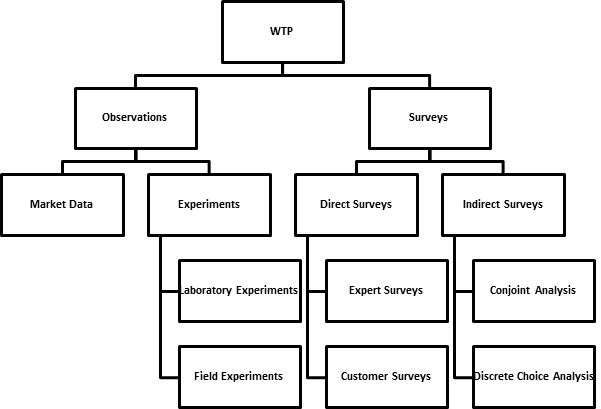Setting the
right price is one of the most complicated decisions to take but also one of
the most rewarding. To choose the price that maximizes revenues and benefits,
it is necessary to determine the willingness to pay (WTP) of customers.
Ideally, we should define the WTP of each customer, but in most cases it is
only possible to establish the WTP for several customer segments.
We can
define the WTP as the highest price that a person will accept to buy a product
or service. However, it is useful to differentiate between two concepts: the maximum
price and the reference price.[1] The maximum price is the value of a
reference product plus the differentiation value of the product of interest; for
example, the WTP of brand B is the value of brand A plus the differentiation
value between the two brands. The reference price is the highest price that a
person would pay for a product or service assuming that she has no alternative.
In conclusion, we can say that the WTP is either the maximum price or the
reference price depending on which is the lowest. Several methods can be used
for the estimation of the WTP, which can be divided into two main groups: observations
and surveys.
Classification of Methods for WTP Estimation14
MARKET DATA
The
advantage of market data is that they are easily accessible and imply no cost other
than the time dedicated to the analysis. However, there are several drawbacks:
- Usually
there is not enough price variation in the data to test the necessary range of
WTP;
- We
are only analyzing our customers and not the market as a whole;
- We
can just define whether an individual has a higher WTP than the selling price,
and we lose information about customers who decided not to purchase the product;
- Usually
demand curves are estimated through regressions, and in this case several
conditions have to be met (see 36. INTRODUCTION TO REGRESSIONS).
EXPERIMENTS
There are
two main kinds of experiments:
- Laboratory
experiments: purchase behavior is simulated in scenarios in which prices and
products are changed (a main drawback is that the purchase intention can be
biased, since the participants are aware of the experiment and because they are
not spending their money or real money);
- Field
experiments: these are tests in which different prices and products are offered
to customers for real purchase.
A general
drawback of experiments is that they are quite costly.
DIRECT SURVEYS
Surveys are
a faster and less expensive method for determining the WTP. Either experts or
customers directly can be interviewed. In the first case, sales and marketing
experts are asked to predict the WTP of customers. This method usually performs
better in situations in which the number of customers is small, while it
performs poorly when the customer base is large and heterogeneous. In this case
it is preferable to conduct customer surveys to ask customers their WTP
directly. A widely used technique is the one proposed by Van Westendorp. Although
this method is easy and direct, it has several drawbacks:
- Customers
can have incentives to underestimate their WTP (to influence real product
prices) or to overestimate their WTP (to show a better social status in front
of researchers);
- Even
if customers try to reveal their true WTP, this is a difficult and complicated
task and the response can be biased unconsciously by several factors;
- If
buyers have no market reference, they can overestimate their WTP.
INDIRECT SURVEYS
With
indirect surveys a situation more similar to the purchase process is presented,
since the respondents are asked to indicate whether they would purchase a
specific product with a specific price or not. For this reason the performance
tends to be better than that of direct surveys. There are two main techniques: conjoint
analysis and discrete choice analysis.
Conjoint Analysis
Different
products with varying attributes and price are presented to the respondents,
who are asked to rank them. Since it is not possible to determine whether the
respondents would buy the product at the presented price, usually they are also
asked to identify a limit below which they will not buy the product. A
disadvantage of this method is that the usual market prices are shown;
therefore, if the respondents’ WTP is not included in these prices, the
estimated WTP can be quite different from the true one.
Discrete Choice Analysis
As in conjoint analysis, products are decomposed
into attributes for which the utility is calculated. However, in discrete
choice analysis, the respondents have to choose a product from a set of several
alternatives. The main methodological difference is that attributes’ utility is
estimated at an aggregated level (the population), while in conjoint analysis it
is calculated for each individual. To estimate the utility at the individual
level, the results of discrete choice analysis can be processed using a
hierarchical Bayes approach


